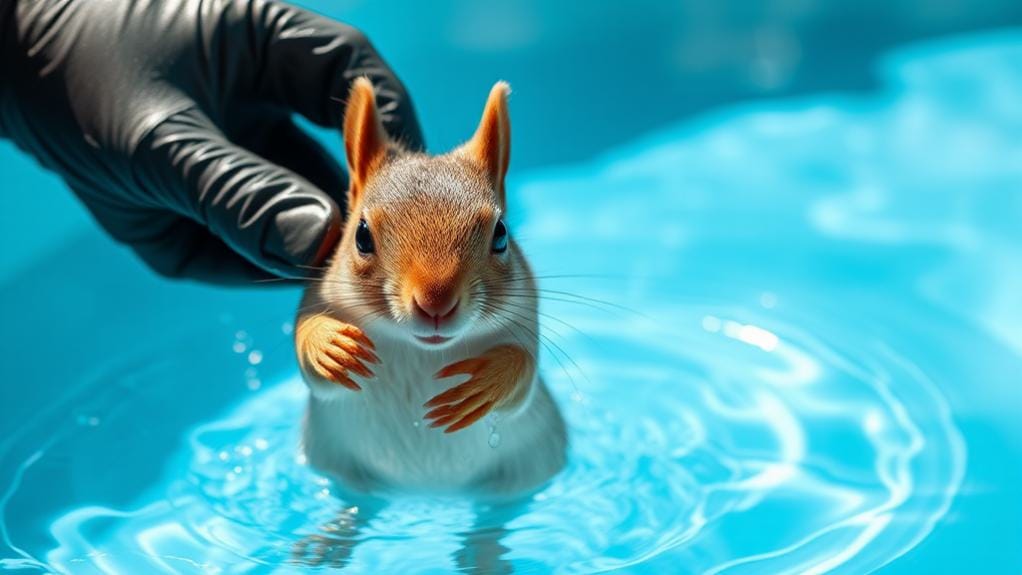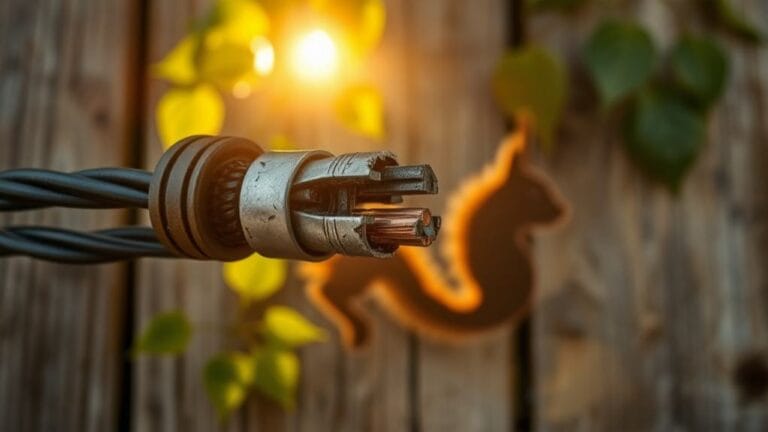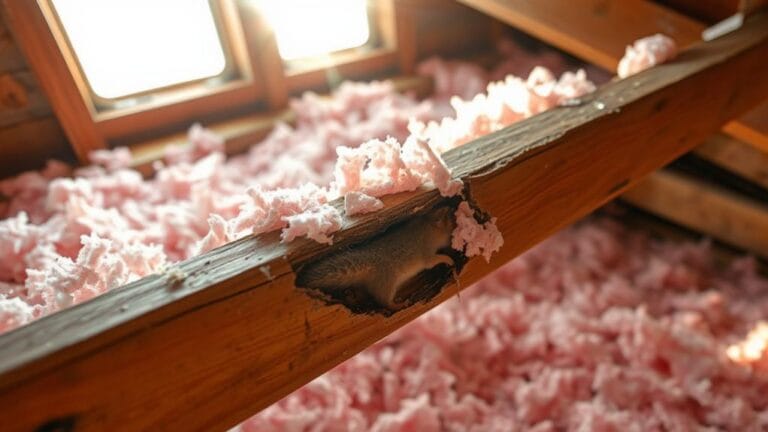No squirrel wants to take an unexpected pool plunge, but when they do, you'll need to act fast. Keep essential rescue gear handy: heavy-duty gloves, a pool skimmer, and a sturdy pet carrier. Approach quietly to avoid startling the distressed critter, then use the skimmer to gently scoop them out. Once rescued, keep them warm and contact a wildlife rehabilitator ASAP. Prevention is your best friend – install Skamper-Ramps, secure garbage, and trim those tempting diving-board branches near your pool. But there's way more to keeping these furry acrobats safe than just basic rescue know-how.
Pool Safety Prevention Strategies
Table of Contents
Swimming pools' hidden dangers extend beyond human safety concerns to the well-being of local wildlife, particularly squirrels.
You'd be surprised how many of these furry daredevils end up taking an unwanted swim. Understanding their nesting behavior patterns and tendency to build dreys high in trees makes pool safety even more critical.
Let's fix that.
Start with the basics – because nobody wants to play lifeguard to a panicking squirrel:
- Trim those overhanging branches. Seriously, do it now. They're like diving boards for curious critters.
- Install ledges along the sides of your pool. These aren't fancy pool accessories – they're literal lifesavers.
- Get a Skamper-Ramp or FrogLog. These gadgets are worth every penny.
Pro Tip: Keep your garbage locked up tight. A buffet of leftovers will attract wildlife faster than a poolside BBQ attracts hungry neighbors.
Remember: Prevention beats rescue every time. Your pool shouldn't be a wildlife challenge course.
Rescue Equipment and Tools
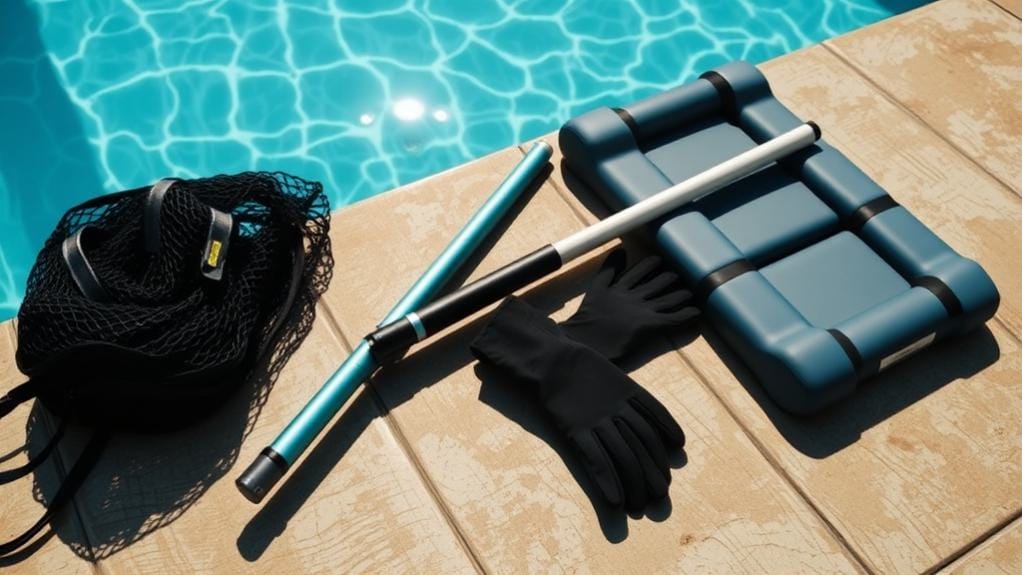
Inside every pool owner's emergency kit should be essential tools for wildlife rescue, particularly when it comes to helping distressed squirrels.
Don't think you'll need them? Trust me, you'll thank me later.
Consider using non-lethal cage traps for safe capture if the squirrel makes it out of the pool but remains in your yard. These humane options are perfect for relocating the rescued animal.
Your must-have rescue equipment includes:
- Heavy-duty gloves – because nobody wants bite marks as souvenirs
- A sturdy pet carrier – cardboard boxes are amateur hour
- A leaf skimmer or pool net – it's not just for leaves anymore
- Clean towels – essential for wrapping up your furry friend
Pro Tip: Keep these items together in an easily accessible spot. When there's a panicked squirrel doing the backstroke in your pool, you won't have time for a scavenger hunt.
Remember: Never attempt feeding until you've consulted a wildlife expert.
That cookie you're thinking about offering? Yeah, don't.
Emergency Response Steps
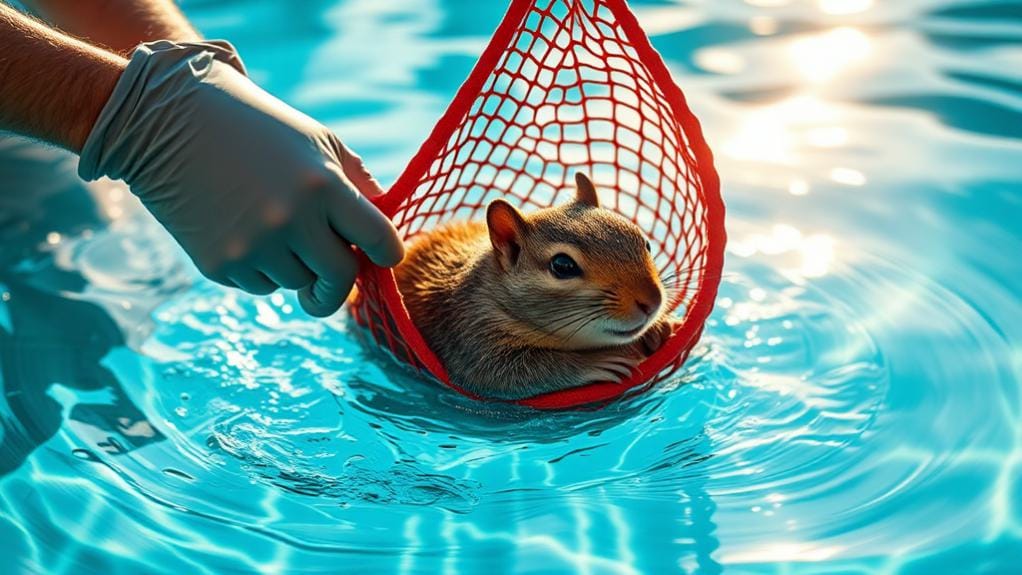
Now that you've got your rescue equipment ready, let's focus on the immediate steps you'll need to take when spotting a squirrel in your pool.
Time to help animals in distress like the hero you are! Remember that squirrels are skilled wall climbers, so they may just need a proper escape route.
1. Stay calm and approach quietly – no need to channel your inner action movie star and make a dramatic entrance.
You'll just freak out the poor squirrel.
2. For tiny squirrels, grab that pool skimmer and scoop gently.
Think of it as fishing, but way more urgent.
3. Got a bigger squirrel? Create a makeshift ramp with a pool float.
They're surprisingly good climbers when given a chance.
4. Watch that rescued squirrel like a hawk.
If it's acting weird or not moving, don't play doctor – call a wildlife rehabilitator ASAP.
*Pro Tip: Always wear gloves. Those cute little critters can pack a punch when scared!*
After Rescue Care

After pulling a squirrel from your pool, immediate care becomes critical for its survival. These small animals need round-the-clock attention – and no, your leftover pizza won't cut it as proper nutrition.
For safe handling, using protective double-layered gloves that extend to your elbow will prevent unexpected bites during care.
Here's what you absolutely must do:
- Keep them warm (yes, even in summer)
- Feed them every 3 hours with specialized formula – seriously, don't even think about cow's milk
- Watch for signs of distress like a hawk – if they're not moving, you've got bigger problems
Pro Tip: Always wear gloves when handling. Those tiny teeth aren't just for cracking nuts.
Contact a wildlife rehabilitator ASAP. They're the pros who actually know what they're doing.
Until then, you're basically running a 24/7 squirrel intensive care unit. Not what you planned for your weekend, right?
Pool Design Modifications
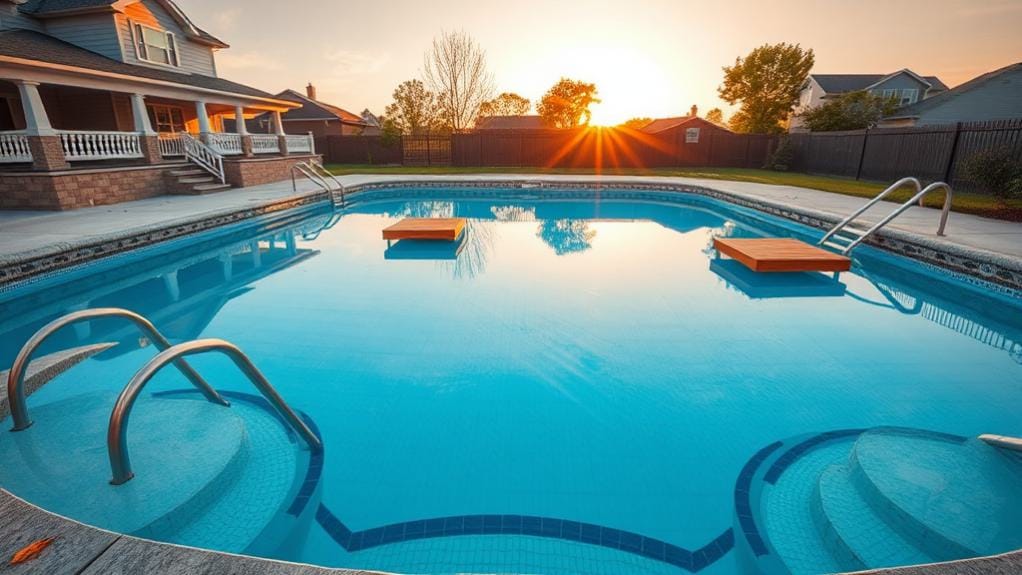
Before another squirrel takes an unplanned dip in your pool, smart design modifications can prevent wildlife emergencies.
Let's face it – your pool shouldn't be a wildlife trap. Much like weight-activated protection keeps critters away from bird feeders, proper pool barriers are essential for wildlife safety. It's time to squirrel-proof that watery paradise of yours.
- Install a pool skimmer cover and surround your pool with proper fencing. Yes, it's an investment, but cheaper than therapy after finding critters in distress.
- Add lounge ledges along the edges. They're not just for your lazy summer floating – they're escape routes for desperate swimmers.
- Mount Skamper-Ramps or Froglogs near the water surface. These nifty devices are literal lifesavers.
- Secure knotted nylon ropes at water level. Think of them as tiny emergency exit ladders for your furry neighbors.
*Pro tip: Built-in ramps aren't just fancy pool features – they're your best defense against becoming an accidental wildlife rescue center.*
Community Resources and Support
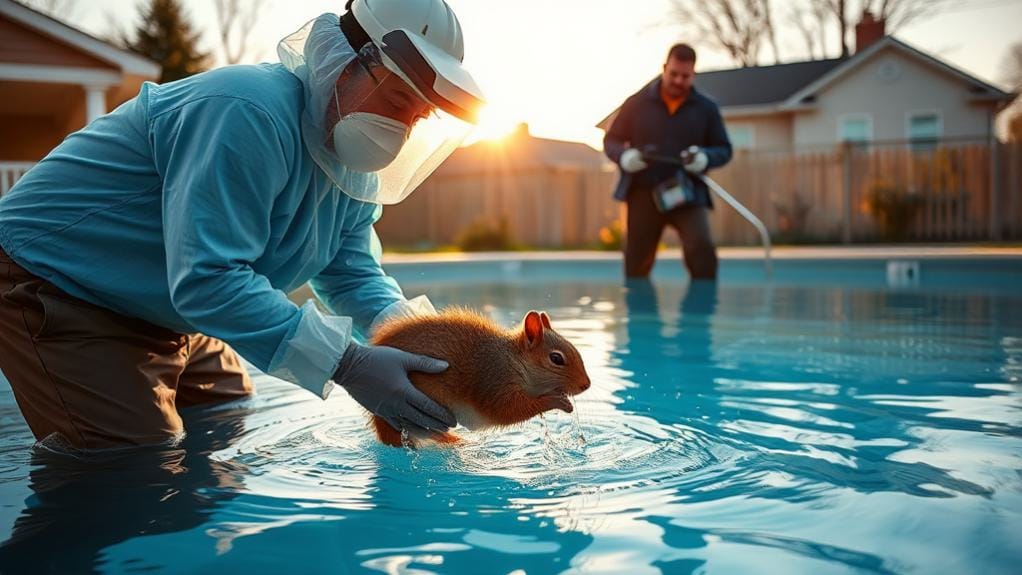
Your community's wildlife rescue network stands ready to help when pool mishaps occur.
Don't play hero alone – tap into the expertise of local wildlife rehabilitators who've seen it all (yes, even that squirrel doing the backstroke in your pool).
Want to level up your rescue game? Here's how:
- Connect with community organizations hosting wildlife workshops – they're literally waiting to teach you
- Save emergency wildlife hotline numbers in your phone (because no one wants to Google while a squirrel's in distress)
- Join local rescue groups as a volunteer – hands-on experience beats YouTube tutorials any day
- Support habitat conservation efforts to keep critters out of pools in the first place
*Pro Tip: Most regions have online directories of certified wildlife rescuers. Bookmark them now, thank yourself later.*
Frequently Asked Questions
How to Keep Squirrels Away From a Swimming Pool?
You'll need to trim tree branches near the pool, install covers when it's not in use, secure garbage cans tightly, and create barriers. These steps will discourage squirrels from accessing your pool area.
Is It Safe to Swim in a Pool With a Dead Squirrel?
No, you shouldn't swim in a pool with a dead squirrel. It's dangerous as the carcass can spread bacteria and parasites. Remove the animal, shock the pool with chlorine, and wait until it's properly sanitized.
What to Do if You Find a Squirrel in Your Pool?
If you spot a squirrel in your pool, extend pool noodles or flotation devices immediately. You'll want to guide it toward the shallow end using a skimmer, and provide chairs for climbing to safety.
How to Save a Drowning Squirrel?
Like a guardian angel, you'll need to act fast! Extend a pool float or skimmer to guide the struggling squirrel toward safety. Don't grab them directly – let them climb onto the rescue device.
Last Word
Saving swimming squirrels isn't just about scooping up soaked critters. You're now prepared with proper prevention, perfectly planned procedures, and plenty of practical tools. Don't let your pool become a perilous trap – you've got the know-how to rescue these rascals right. Remember: swift action saves lives, and your newfound skills make you the neighborhood's premier pool patrol. Keep your rescue gear ready, your eyes alert, and your net nearby. Those bushy-tailed buddies are counting on you!

